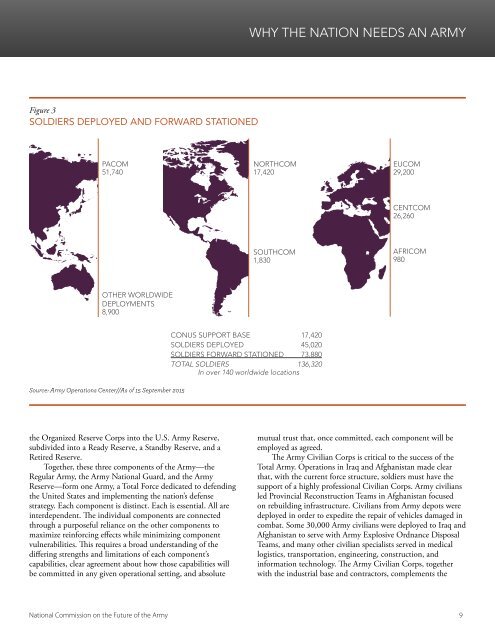THE FUTURE OF THE ARMY
Futurearmy
Futurearmy
You also want an ePaper? Increase the reach of your titles
YUMPU automatically turns print PDFs into web optimized ePapers that Google loves.
WHY <strong>THE</strong> NATION NEEDS AN <strong>ARMY</strong><br />
Figure 3<br />
SOLDIERS DEPLOYED AND FORWARD STATIONED<br />
PACOM<br />
51,740<br />
NORTHCOM<br />
17,420<br />
EUCOM<br />
29,200 *Chairperson<br />
CENTCOM<br />
26,260<br />
SOUTHCOM<br />
1,830<br />
AFRICOM<br />
980<br />
O<strong>THE</strong>R WORLDWIDE<br />
DEPLOYMENTS<br />
8,900<br />
Source: Army Operations Center//As of 15 September 2015<br />
CONUS SUPPORT BASE 17,420<br />
SOLDIERS DEPLOYED 45,020<br />
SOLDIERS FORWARD STATIONED 73,880<br />
TOTAL SOLDIERS 136,320<br />
In over 140 worldwide locations<br />
the Organized Reserve Corps into the U.S. Army Reserve,<br />
subdivided into a Ready Reserve, a Standby Reserve, and a<br />
Retired Reserve.<br />
Together, these three components of the Army—the<br />
Regular Army, the Army National Guard, and the Army<br />
Reserve—form one Army, a Total Force dedicated to defending<br />
the United States and implementing the nation’s defense<br />
strategy. Each component is distinct. Each is essential. All are<br />
interdependent. The individual components are connected<br />
through a purposeful reliance on the other components to<br />
maximize reinforcing effects while minimizing component<br />
vulnerabilities. This requires a broad understanding of the<br />
differing strengths and limitations of each component’s<br />
capabilities, clear agreement about how those capabilities will<br />
be committed in any given operational setting, and absolute<br />
mutual trust that, once committed, each component will be<br />
employed as agreed.<br />
The Army Civilian Corps is critical to the success of the<br />
Total Army. Operations in Iraq and Afghanistan made clear<br />
that, with the current force structure, soldiers must have the<br />
support of a highly professional Civilian Corps. Army civilians<br />
led Provincial Reconstruction Teams in Afghanistan focused<br />
on rebuilding infrastructure. Civilians from Army depots were<br />
deployed in order to expedite the repair of vehicles damaged in<br />
combat. Some 30,000 Army civilians were deployed to Iraq and<br />
Afghanistan to serve with Army Explosive Ordnance Disposal<br />
Teams, and many other civilian specialists served in medical<br />
logistics, transportation, engineering, construction, and<br />
information technology. The Army Civilian Corps, together<br />
with the industrial base and contractors, complements the<br />
National Commission on the Future of the Army 9


